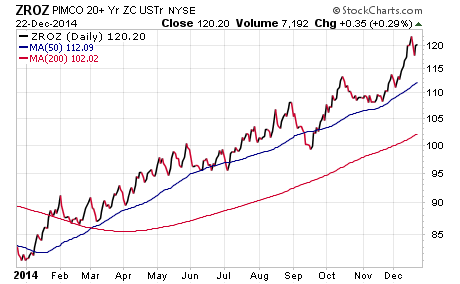The Best Bond Investments for Falling Rates
Post on: 5 Июнь, 2015 No Comment

You can opt-out at any time.
Please refer to our privacy policy for contact information.
The conventional wisdom is that all segments of the bond market will perform well when prevailing rates are falling, but that’s not necessarily true. Certain sectors tend to benefit more than others, and some may actually be hurt. The question, then, is what are the best investments when rates are dropping, and what market segments may be best to avoid?
Many investors believe that the higher-risk segments of the market – such as high-yield bonds and emerging market debt – will automatically deliver the best performance when rates are going down. However, longer-maturity and higher-quality investments are in fact among those most likely to outperform.
The reason for this is that interest rate risk and credit risk are two entirely different things. The first is the degree to which interest rate movements affect an investment; the second is the risk that a bond could be adversely impacted by a deterioration in the issuer’s finances. As a result, bonds with higher interest rate risk tend to perform well when rates are falling, while those with higher credit risk may not.
Longer-term Bonds Benefit From Falling Rates
Longer-term bonds have higher interest rate risk than either short — or interemediate-term bonds, so they typically deliver the best performance when rates fall.
The difference in the performance results of long- and short-term bonds can be dramatic. In 2011, for instance, the iShares Trust Barclays 20+ Year Treasury Bond Fund (ticker:TLT), an exchange-traded fund that focuses on the longest-term bonds in the U.S. Treasury market, returned a gaudy 34.0%. In contrast, the iShares Trust Barclays 1-3 Year Treasury Bond ETF (SHY), a short-term fund, returned just 1.45% in the same period. It helps to think of the price action along the maturity spectrum as similar to the movement of a whip: the section closest to the handle (short-term bonds) moves the least, while the portion furthest away from the handle (longer-term bonds) moves the most.
Among longer-term issues, bonds with the lowest credit risk – such as U.S. Treasuries, Treasury Inflation-Protected Securities (TIPS), government-issued zero coupon bonds. and higher-quality municipal and corporate bonds – tend to benefit most when rates fall. However, the same isn’t necessarily true for lower-quality investments.
Credit Risk: A Different Animal
There are several reasons why bonds with higher credit risk – such as high yield, emerging market, and lower-quality investment-grade corporate debt – may not necessarily perform well when rates are falling.
First, declining yields in government bonds can be the result of a “flight to quality ” into the safest assets. During these times, investors tend to gravitate away from assets with higher credit risk.
Second, a decline in prevailing rates can be a sign of slowing economic growth. Since many corporate, high yield, and emerging market issuers tend to benefit when growth is robust (since it reduces their credit risk), an economic slowdown tends to have the opposite effect on them as it does government issues.
Third, lower-quality bonds have yields that are well above those on higher-quality issues, so a change in yield has less of an impact on their “yield spread .” For instance, if the 10-year Treasury moves from 2.5% to 2.0%, a bond yielding 3.0% needs to make a larger adjustment (3.0% to 2.5%) on a percentage basis than one yielding 8%. In short, that 0.5% drop in rates is much more meaningful to a bond yielding one percentage point more than Treasuries than it is for one with a yield advantage of, for example, five percentage points.
The Bottom Line
While risk and reward go hand-in-hand, in the bond market it’s the type of risk that counts the most. If you want to take advantage of falling rates, be sure that you’re investing in a security with higher interest-rate risk, not higher credit risk.














